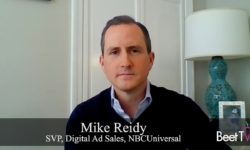Connected TV has come a long way – but it still has a little way to go to fully realize the dreams of efficient, data-driven advertising that reaches individual homes.
EMarketer forecasts US connected TV ad spending will reach $18.29 billion by 2024, more than double the amount spent in 2020, driven especially by YouTube, Hulu, and Roku.
In this video interview with Beet.TV, Jay Prasad, Chief Strategy Officer for TV at LiveRamp, explains that, after fast growth, some development is still needed.
TV growth
According to eMarketer’s data, US CTV ad spend jumped 27.1% through 2020 – a year when viewing was swelled by staying at home and advertising was boosted by both US elections and a range of new AVOD entrants.
But Prasad says much of the buying in CTV has been traditional in form.
“It’s odd that, in the run-up to all of this growth in streaming, a lot of it’s been done with maybe just age and gender (targeting) capabilities.,” he says. “In part, (that is) because of the difficulty in being able to assess how much audience-based inventory exists in the marketplace.
“(Buyers) want to look at high quality data from reputable data firms, companies like Catalina and Polk and others who have high-quality data that’s been working in digital and then has been working in addressable linear.”
Jay Prasad, Chief Strategy Officer at LiveRamp TV says our collaboration with Kinetiq tackles antiquated measurement and attribution in TV head-on by streamlining measurement of all TV ad exposures across traditionally siloed channels. https://t.co/rTv3jtTvA8 #Martech #Technology pic.twitter.com/k2NgP3J5NF
— MarTech Series (@MarTechSeries) January 11, 2021
Custom audiences
Prasad says the ability to create “custom audiences” for targeting, a practice that has been enjoyed by other digital buyers for some time, is now emerging in connected TV.
“These custom audiences can be based on their own first-party data – things like purchase history – or the ability to look at prospects differently than existing customers,” he says.
Other new capabilities include using CTV to control the reach and frequency of ads, or to measure the outcome of ads.
How will programmatic buyers approach CTV inventory this year?
If you missed our blog about the buy side practice of supply path optimization (SPO), here is another chance to read how it can impact streaming AVOD publishers and some best practices: https://t.co/yg73gC4M5j
— Publica by IAS (@getpublica) January 14, 2021
Household intelligence
But having the custom audience capability isn’t enough, Prasad reckons.
“Once you have this custom audience, how do you make it work in CTV?,” he says. “That’s sort of that last-mile question that has been looking at the industry as a big opportunity.
“And we’re now looking at how we can make that happen between buyers and sellers and working with some key partners to do that.”
Prasad says the big opportunity is to generate intelligence at the level of individual ad impressions, which correlate to individual households – a step-change from the traditional TV panel measurement picture.
That means applying more data about the household in question, including the size of the household, and being able to de-duplicate that household from receiving too many ads – a problem Prasad’s LiveRamp is working on with Publica, a connected TV advertising platform.
You are watching “Making CTV Happen: A New Ad Infrastructure Emerges,” a Beet.TV leadership video series presented by Publica. For more videos, please visit this page.




































